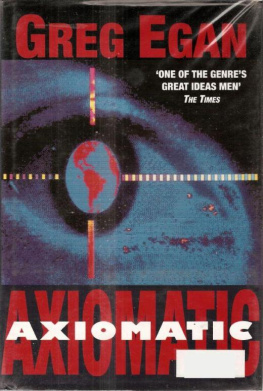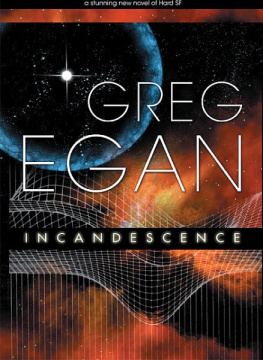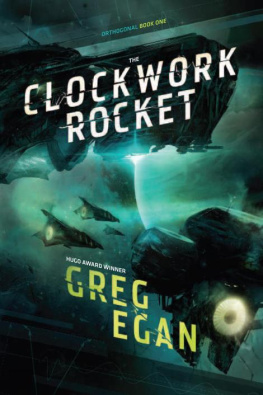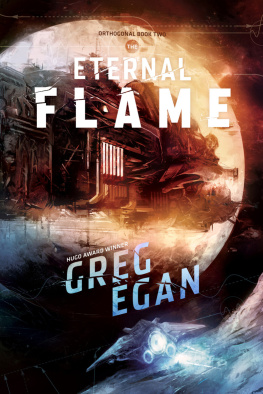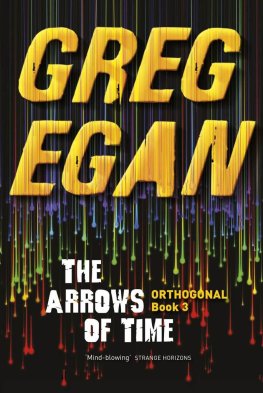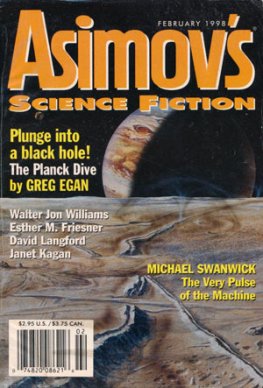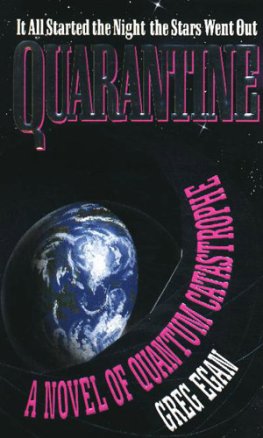Greg Egan - Luminous
Here you can read online Greg Egan - Luminous full text of the book (entire story) in english for free. Download pdf and epub, get meaning, cover and reviews about this ebook. year: 1998, publisher: Gollancz, genre: Art / Science fiction. Description of the work, (preface) as well as reviews are available. Best literature library LitArk.com created for fans of good reading and offers a wide selection of genres:
Romance novel
Science fiction
Adventure
Detective
Science
History
Home and family
Prose
Art
Politics
Computer
Non-fiction
Religion
Business
Children
Humor
Choose a favorite category and find really read worthwhile books. Enjoy immersion in the world of imagination, feel the emotions of the characters or learn something new for yourself, make an fascinating discovery.

- Book:Luminous
- Author:
- Publisher:Gollancz
- Genre:
- Year:1998
- Rating:5 / 5
- Favourites:Add to favourites
- Your mark:
- 100
- 1
- 2
- 3
- 4
- 5
Luminous: summary, description and annotation
We offer to read an annotation, description, summary or preface (depends on what the author of the book "Luminous" wrote himself). If you haven't found the necessary information about the book — write in the comments, we will try to find it.
Luminous — read online for free the complete book (whole text) full work
Below is the text of the book, divided by pages. System saving the place of the last page read, allows you to conveniently read the book "Luminous" online for free, without having to search again every time where you left off. Put a bookmark, and you can go to the page where you finished reading at any time.
Font size:
Interval:
Bookmark:
El Nido de Ladrones -- the Nest of Thieves -- occupies a roughly elliptical region, fifty thousand square kilometers in the western Amazon Lowlands, straddling the border between Colombia and Peru. It's difficult to say exactly where the natural rain forest ends and the engineered species of El Nido take over, but the total biomass of the system must be close to a trillion tonnes. A trillion tonnes of structural material, osmotic pumps, solar energy collectors, cellular chemical factories, and biological computing and communications resources. All under the control of its designers.
The old maps and databases are obsolete; by manipulating the hydrology and soil chemistry, and influencing patterns of rainfall and erosion, the vegetation has reshaped the terrain completely: shifting the course of the Putumayo River, drowning old roads in swampland, raising secret causeways through the jungle. This biogenic geography remains in a state of flux, so that even the eye-witness accounts of the rare defectors from El Nido soon lose their currency. Satellite images are meaningless; at every frequency, the forest canopy conceals, or deliberately falsifies, the spectral signature of whatever lies beneath.
Chemical toxins and defoliants are useless; the plants and their symbiotic bacteria can analyze most poisons, and reprogram their metabolisms to render them harmless -- or transform them into food -- faster than our agricultural warfare expert systems can invent new molecules. Biological weapons are seduced, subverted, domesticated; most of the genes from the last lethal plant virus we introduced were found three months later, incorporated into a benign vector for El Nido's elaborate communications network. The assassin had turned into a messenger boy. Any attempt to burn the vegetation is rapidly smothered by carbon dioxide -- or more sophisticated fire retardants, if a self-oxidizing fuel is employed. Once we even pumped in a few tonnes of nutrient laced with powerful radioisotopes -- locked up in compounds chemically indistinguishable from their natural counterparts. We tracked the results with gamma-ray imaging: El Nido separated out the isotope-laden molecules -- probably on the basis of their diffusion rates across organic membranes -- sequestered and diluted them, and then pumped them right back out again.
So when I heard that a Peruvian-born biochemist named Guillermo Largo had departed from Bethesda, Maryland, with some highly classified genetic tools -- the fruits of his own research, but very much the property of his employers -- and vanished into El Nido, I thought: At last, an excuse for the Big One. The Company had been advocating thermonuclear rehabilitation of El Nido for almost a decade. The Security Council would have rubber-stamped it. The governments with nominal authority over the region would have been delighted. Hundreds of El Nido's inhabitants were suspected of violating US law -- and President Golino was aching for a chance to prove that she could play hard ball south of the border, whatever language she spoke in the privacy of her own home. She could have gone on prime time afterward and told the nation that they should be proud of Operation Back to Nature, and that the thirty thousand displaced farmers who'd taken refuge in El Nido from Colombia's undeclared civil war -- and who had now been liberated forever from the oppression of Marxist terrorists and drug barons -- would have saluted her courage and resolve.
I never discovered why that wasn't to be. Technical problems in ensuring that no embarrassing side-effects would show up down-river in the sacred Amazon itself, wiping out some telegenic endangered species before the end of the present administration? Concern that some Middle Eastern warlord might somehow construe the act as license to use his own feeble, long-hoarded fission weapons on a troublesome minority, destabilizing the region in an undesirable manner? Fear of Japanese trade sanctions, now that the rabidly anti-nuclear Eco-Marketeers were back in power?
I wasn't shown the verdicts of the geopolitical computer models; I simply received my orders -- coded into the flicker of my local K-Mart's fluorescent tubes, slipped in between the updates to the shelf price tags. Deciphered by an extra neural layer in my left retina, the words appeared blood red against the bland cheery colors of the supermarket aisle.
I was to enter El Nido and retrieve Guillermo Largo.
Alive.
Dressed like a local real estate agent -- right down to the gold-plated bracelet-phone, and the worst of all possible three-hundred-dollar haircuts -- I visited Largo's abandoned home in Bethesda: a northern suburb of Washington, just over the border into Maryland. The apartment was modern and spacious, neatly furnished but not opulent -- about what any good marketing software might have tried to sell him, on the basis of salary less alimony.
Largo had always been classified as brilliant but unsound -- a potential security risk, but far too talented and productive to be wasted. He'd been under routine surveillance ever since the gloriously euphemistic Department of Energy had employed him, straight out of Harvard, back in 2005 -- clearly, too routine by far ... but then, I could understand how thirty years with an unblemished record must have given rise to a degree of complacency. Largo had never attempted to disguise his politics -- apart from exercising the kind of discretion that was more a matter of etiquette than subterfuge; no Che Guevara T-shirts when visiting Los Alamos -- but he'd never really acted on his beliefs, either.
A mural had been jet-sprayed onto his living room wall in shades of near infrared (visible to most hip fourteen-year-old Washingtonians, if not to their parents). It was a copy of the infamous Lee Hing-cheung's A Tiling of the Plane with Heroes of the New World Order, a digital image that had spread across computer networks at the turn of the century. Early nineties political leaders, naked and interlocked -- Escher meets the Kama Sutra -- deposited steaming turds into each other's open and otherwise empty brain cases -- an effect borrowed from the works of the German satirist George Grosz. The Iraqi dictator was shown admiring his reflection in a hand mirror -- the image an exact reproduction of a contemporary magazine cover in which the mustache had been retouched to render it suitably Hitleresque. The US President carried -- horizontally, but poised ready to be tilted -- an egg-timer full of the gaunt hostages whose release he'd delayed to clinch his predecessor's election victory. Everyone was shoe-horned in, somewhere -- right down to the Australian Prime Minister, portrayed as a pubic louse, struggling (and failing) to fit its tiny jaws around the mighty presidential cock. I could imagine a few of the neo-McCarthyist troglodytes in the Senate going apoplectic, if anything so tedious as an inquiry into Largo's defection ever took place -- but what should we have done? Refused to hire him if he owned so much as a Guernica tea-towel?
Largo had blanked every computer in the apartment before leaving, including the entertainment system -- but I already knew his taste in music, having listened to a few hours of audio surveillance samples full of bad Korean Ska. No laudable revolutionary ethno-solidarity, no haunting Andean pipe music; a shame -- I would have much preferred that. His bookshelves held several battered college-level biochemistry texts, presumably retained for sentimental reasons, and a few dozen musty literary classics and volumes of poetry, in English, Spanish, and German. Hesse, Rilke, Vallejo, Conrad, Nietzsche. Nothing modern -- and nothing printed after 2010. With a few words to the household manager, Largo had erased every digital work he'd ever owned, sweeping away the last quarter of a century of his personal archaeology.
Font size:
Interval:
Bookmark:
Similar books «Luminous»
Look at similar books to Luminous. We have selected literature similar in name and meaning in the hope of providing readers with more options to find new, interesting, not yet read works.
Discussion, reviews of the book Luminous and just readers' own opinions. Leave your comments, write what you think about the work, its meaning or the main characters. Specify what exactly you liked and what you didn't like, and why you think so.

